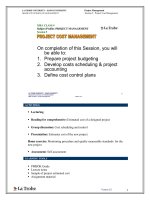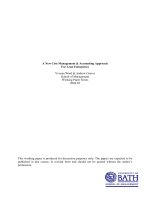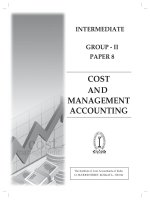Cost management training day1
Bạn đang xem bản rút gọn của tài liệu. Xem và tải ngay bản đầy đủ của tài liệu tại đây (1.42 MB, 83 trang )
Cost Management
Training Agenda/Objectives
• Day 1: Cost Management Overview
– Understanding of why managing costs are important, Army’s
overall objectives, the process of Cost Management, how it
differs from Budget, and key cost terms
• Day 2: Cost Object Definition
– Understanding of an ERP, how to build a Cost Model, and the
various cost objects within a Cost Model (e.g. organization,
products, job orders, etc.)
• Day 3: Assignment of Costs
– Understanding of cost allocations/assignments, how to chose
which to utilize when, how to valuate the results of the
assignments (Std. vs Actual), and rate creation
• Day 4: Analysis and Reporting
– Understanding of the results of the Cost Model and how various
types of analysis and decisions are supported
Riddle Me This….?
•
•
•
•
Could you tell your customers the full cost of
providing them their products or services?
Could you answer the same question by
quarter or for the next quarter?
Could you tell customers how changes in their
behaviors might affect their costs?
How would you determine the cost to operate
your DOL or provide a specific Service/SSP?
What costs would you include?
What is your “show me” source?
•
Let’s view a real life example of Cost
Management in action!
Pa & Ma Kettle Math Video
Day 1 Objective & Agenda
Day 1: Cost Management Overview
• Understanding of why managing costs are
important, Army’s overall objectives, the process
of Cost Management, how it differs from Budget,
and key cost terms
–
–
–
–
–
Lesson 1: Cost Awareness
Lesson 2: Cost Culture
Lesson 3: Cost vs. Budget
Lesson 4: Cost Management
Lesson 5: Cost Terms
Lesson 1: Cost Awareness
Objective(s):
• To understand the external and internal
factors requiring the Army to instill Cost
Management as a fundamental approach
for day to day activities
Army Stakeholders
Taxpayers,
Congress,
OSD,
Customers
External
Internal
ARMY
HQHQ
ARMY
Strategic
IMCOM HQ
IMCOM HQ
Management
Installations
IMCOM
Installations
Operation
External Stakeholder Demands:
Government Industry Mandates
• There Has Been A Push For The Past Decade for the
Ability to Explain How Well An Organization Is Performing
versus What It Is Performing
• More Questions Are Being Asked About - How Much Does
It Cost To? How Efficient Are We At? Versus Where Did
You Spend the Budget?
• Questions on Efficiency Fall Into the Domain of
Management Accounting; Questions of Which Funds
Were Expended Are the Domain of Budget Accounting
Cost – Government History
• Actions Requiring Costs & Performance
– Chief Financial Officers Act (1990)
– Government Performance Results Act (1993)
– President’s Management Agenda (2002)
– OMB Performance Assessment Rating Tool
– OSD Requires Army Performance Budget
• Public Sector GAAP (SFFAS 4) Full Cost (1995)
– Army Developed GFEBS Costing Module
• OSD Actions to Increases Cost Management
– Acquisition Reform (1997)
– OSD (AT&L) Issues ABC Guidance (1999)
– Business Transformation / Lean Six Sigma
Lessons Learned: Cost Measurement Difficult
Cultural Resistance
Army’s Imperatives for Change
Threats
Threats
•
•
•
•
More competing priorities for resources
Over reliance on supplemental funding
Migration of base budget requirements
(training, maintenance, procurement) into
supplementals
Supplemental funding likely to stop prior
to end of hostilities/redeployment of
forces
Opportunities
Opportunities
•
•
•
•
•
Understand cost to accomplish objectives
Optimize base resources as
supplemental funding is discontinued
Understand depreciated value of current
assets and effectively plan for the future
Develop clear and defensible impact
analyses
Change the way the Army does business
to leverage investment in ERP
technology and LSS
ASA(FM&C) Operational Priorities
• Provide accurate, reliable, and timely financial
information and integrated functional
performance data to Army decision makers
• Improve Army accountability and enable full cost
management
• Exchange information with customer and
stakeholders
• Achieve efficiencies and operate effectively
Cost
Management
• Enable the Army to receive and unqualified audit
opinion on annual financial statements with
respect to Army General Funds
Financial
Management
ARMY HQ
IMCOM HQ
IMCOM
Installations
Strategic
Management
Operational
Objective
In order to meet the first 4 operational priorities, the
Army needs to establish a cost culture that:
– functions as a key and integral part of the Army’s
overall management process
– adds value to the organization by enabling the
effective use of resources in dynamic and competitive
contexts
– provides continuous feedback on effective use of
resources to create value for stakeholders
Vision
By obtaining the objectives, the Army can meet its
overall vision of:
• Leaders use cost information for effective decision-making
and performance management by:
– understanding both the near- and long-term cost
implications of their decisions;
– making effective trade-off decisions to achieve the
best possible use of limited resources; and
– holding subordinates accountable for improving the
efficiency and effectiveness of their operations.
• Army soldiers/civilians along the value chain understand
how their efforts contribute to the Army mission and impact
Army resources
Many Types Costs
•
•
•
•
•
•
•
•
•
•
Direct costs— A cost such as labor, materials/supplies that can be
directly traced to producing a specific output of an organization,
product/service.
Indirect costs – A cost that cannot be directly traced to a specific
organization, product/service output.
Funded Costs -- The value of goods or services received because
of an obligation of funds (obligation authority), by the organization
performing the work.
Unfunded costs – A cost that are financed by another
organization's or activity's appropriations.
Variable Costs -- A cost that changes with change in output.
Fixed Cost -- A cost that remains the same regardless of the
change in output.
Sunk Cost -- A cost incurred in the past that will not be affected by
any present or future decision.
Incremental Cost: The increase or decrease in costs that would
result from a decision to increase or decrease output levels.
Avoidable Costs – A cost incurred on an object that will no longer
be incurred due to a decision to change the output.
Unavoidable Cost: A cost incurred on an object that will be
incurred regardless of the decision to change.
• Common
Understanding of
Types of Cost is
Necessary for
Informed
Decision Making
• Each Decision
Should be
Focused on Only
Relevant Cost
that Impact the
Decision
Need to Understand What the
Resources Buy – The Army Product
Sets
Framework for
Developing
Army-wide
Cost Structure
X
X
X
Heavy
X
X
UA
Light
SUST
Stryker
X
SUST
FCS
Force Generation
$ to Reset
$ to Train
$ to Deploy
Training (Ind)
$ / Student Trng Day
$ / Course Day
Base Support
Training (Unit)
$ / Mile
$ / Flying Hour
$ / Weapon System
Personnel
$ / Service
Military -$ / Soldier
$ / Brigade
Civilian - $ / FTE
$ / Installation (SRM, BOS, Contractor - $ / FTE
ENVR, FP)
Equipment
$ / Brigade- New
$ / Brigade-Conversion
Ratio: Sppt $ / Brigade $
ARFORGEN Process
Optimization Impacts Multiple Programs
Reset/Train
• Man
• Equip
• Train
• Sustain
• Operate
Ready
Available
- HQDA
- IMCOM / REGION
- GARRISON
• Population Shifts (Deployments, Training, Etc.)
• Family Programs
• Facilities Utilization
• Maintenance & Repair
• Etc. ..
– TRADOC
– Infantry School
• Course ABC
• Course XYZ
– National Training Center
• Event 123
• Event 456
• Etc…
Lesson 1: Wrap-Up
• External Pressures provide an emotional trigger
• Each level of stakeholders have different objectives &
vision which should align and support total objectives &
visions
• Cost awareness and management as an approach will
be used to shift the focus of budget only, e.g. what was
spent, to performance, e.g. what did we do/get?
Question #1: Based on the HQDA
Strategy of BCT being the Army
Primary Product, How can IMCOM
Impact that Strategy through Cost
Management?
X
X
ANSWER:
X
Heavy
X
X
UA
Light
SUST
Stryker
X
SUST
FCS
Force Generation
$ to Reset
$ to Train
$ to Deploy
Training (Ind)
$ / StudentTrngDay
$ / Course Day
Base Support
Training (Unit)
$ / Mile
$ / Flying Hour
$ / Weapon System
Personnel
$ / Service
Military-$ / Soldier
$ / Brigade
Civilian- $ / FTE
$ / Installation (SRM, BOS, Contractor- $ / FTE
ENVR, FP)
Equipment
$ / Brigade- New
$ / Brigade-Conversion
Ratio:Sppt$ / Brigade $
Question #2: What are some
examples of how IMCOM is
impacted by the Army’s
optimization strategies, i.e.
ARFORGEN Process?
Answer:
Reset/Train
• Man
• Equip
• Train
• Sustain
• Operate
Ready
Available
- HQDA
- IMCOM / REGION
- GARRISON
• Population Shifts (Deployments, Training, Etc.)
• Family Programs
• Facilities Utilization
• Capacity Management (Workload/Output)
• Maintenance & Repair
• Etc.
Lesson 2: Cost Culture
Objective(s):
• Understand the level of effort for
deploying cost awareness throughout the
Army, i.e. generating a Cost Culture
What is a Cost Culture?
Organizational Culture:
• Comprises the Attitudes, Experiences, Beliefs & Values of an
Organization
• A Shared Behavior by People & Groups in an Organization
• Most Experts Agree that it is the Shared “Taken-For-Granted”
Assumptions, Beliefs, Values, Expectations & Rules that
Members of a Work Unit Team or a Corporate Organization
Hold
A Cost Culture is the Cultural Shift from “Accomplish the
Mission at Any Cost” to “Accomplish the Mission
Considering Cost”
Why Focus on Culture?
Deploying Systems, Improving Cost Models, Issuing
Policies, Training Staff, Recruiting Experts
will not Enhance the Army’s ability to manage costs
unless Army Soldiers / Civilians Understand &
Value the Need to Manage Costs
• Knowing Our Costs & Managing Them To Increase Our
Mission Capability Must Become Ingrained in Our Culture
• Leaders Must Demand Cost Information & Use It In
Decision-making — Otherwise It Provides No Utility To The
Army
• We Need A Lifestyle Change, Not A Diet!
Leadership Statements on
a Cost Culture
From Chief of Staff, Army:
• Most Army processes lack a cross-functional focus and cost-benefit analysis which
leads to grossly inefficient application of resources.
• Large budgets in the past few years have produced a consumption-based culture that
focuses on accomplishing missions without concern for more efficient delivery of
capabilities.
From 2008 Army Posture Statement:
• Integral to achieving our goals is the development of an Army-wide cost-management
culture in which leaders better understand the full cost of the capabilities they use
and provide and incorporate cost considerations into their planning and decisionmaking. This approach will enable us to achieve readiness and performance
objectives more efficiently.
From HONORABLE Nelson Ford, ASA (FM&C):
• The cultural change that is essential to Army financial management, and without
which all the other improvements will leave us short of achieving our goals, is the
adoption and integration of cost management into the Army culture.
Creating A Cost Culture
Cost Culture Vision:
Leaders Use Cost
Information for
Effective DecisionMaking &
Performance
Management by …
Understanding Both Near & Long-Term Cost
Implications of Their Decisions
Making Effective Trade-Off Decisions to
Achieve Best Use of Limited Resources
Holding Subordinates Accountable for
Improving the Efficiency & Effectiveness of
operations
Cost Culture Take - Aways:
•
Know the True Cost of What You Do - Not Knowing Cost Makes Everything
Appear Free -- “Free Goods Have Infinite Demand”
•
Cost Management is Not Easy -- You Have to Know What Drives Costs &
Take Action to Control Costs
•
Cost Management Goes Beyond “Do More With Less” - It Is Optimizing
Resources to Efficiently and Effectively Meet Mission -- “Focused on
Continuous Improvement”
Business Culture Change Process
“Making a Square a Circle”
• The Culture Is Defined By
What, Who, Why, And How
Business Is Conducted
• The Culture Is Imbedded
in People, Processes and
Technologies
• “We’ve Always Done It
This Way”
• Influencing A Culture
Requires Changes To The
Components Of A Culture
People &
Other Resources
How
To’s
Policy
Processes,
Policies & Procedures
Tools &
Technologies
Enablers of Change
• Visualize and Define
What You Want To Be
• “We’re going to be…”









